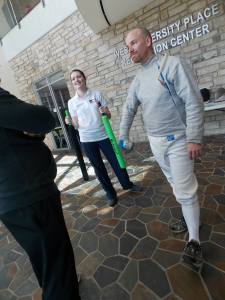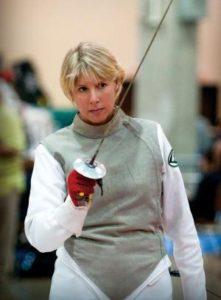Fencing: Safe, “Even though the goal is to stab your opponent”
Fencing seems like a fast-paced and violent sport, yet its injury rate is very low compared to other sports – as we are always happy to point out, you are more likely to be injured playing badminton than fencing. A 2012 Scientific American article ranked all summer and winter Olympic sports according to how many of each sport’s athletes were injured during training or the games. (http://www.scientificamerican.com/article/leg-head-injuries-frequent-at-olympics/). The fact that fencing was ranked as one of the safest sports is no surprise to experienced fencers, but seems to have surprised the author of this article, who pointed out fencing’s low injury rate specifically and said “Even though the goal is to stab your opponent.”
If you think about fencing’s origins, it makes sense that we would work hard to reduce our injury rate. Fencing started as training for duels, and the people who were training for duels wanted to make sure they didn’t die. They started by simply blunting their weapons with a large wad of leather, which they thought looked like a flower or florette – this is where the term foil comes from. These wads of leather had to be about the size of your eye socket, so that accidental hits to the eye wouldn’t gouge out your eye.
Over the years we’ve improved our safety equipment beyond that simple wad of leather. Today’s fencer, in competition gear, is covered from head to toe with the exception of the back of the head and the back hand. If you keep your back arm out of the way and don’t turn away from your opponent (both of these are rules violations, anyway), your bare skin should never come in contact with your opponent’s weapon.
The essential pieces of gear for practice are the underarm protector, the jacket, the glove, and the mask. Some competitors also wear plastic chest protectors. Fencing pants and knee socks are required for competition, and a good idea although not required for practice. If you’re using the electric scoring system you’ll add more gear, but we’ll cover electric gear in a future post.
 Plastic chest protectors are required for youth events and for women of all ages. They can be worn by teen and adult men, but usually aren’t. The original requirement for women to wear chest protectors came from the mistaken belief that hits to the breasts caused breast cancer. Researchers have since disproven that, but most women prefer the added protection, so the rule has stayed in place.
Plastic chest protectors are required for youth events and for women of all ages. They can be worn by teen and adult men, but usually aren’t. The original requirement for women to wear chest protectors came from the mistaken belief that hits to the breasts caused breast cancer. Researchers have since disproven that, but most women prefer the added protection, so the rule has stayed in place.
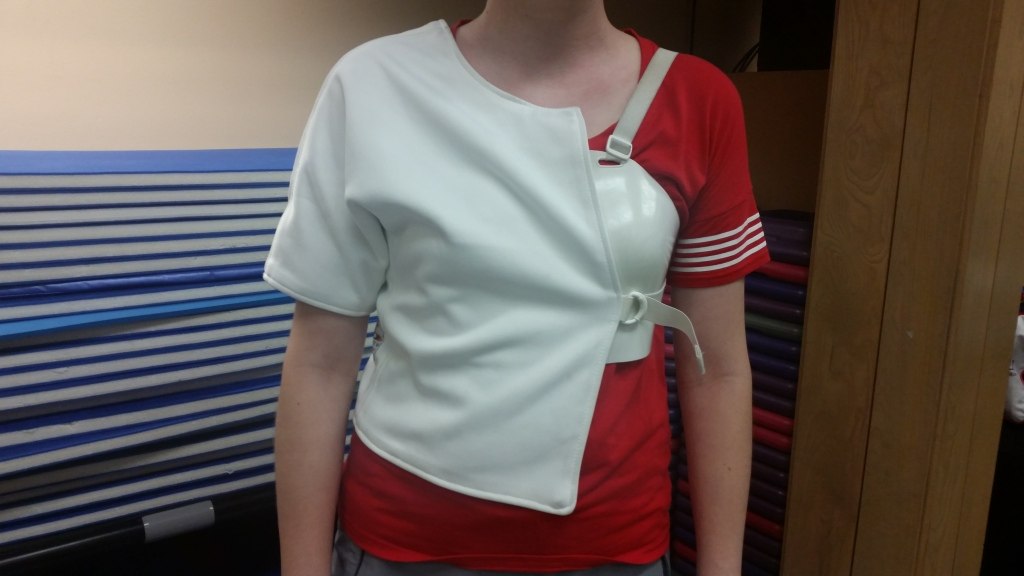 The underarm protector is more formally called the plastron and more informally called the armpit protector. It’s a half-jacket that covers the fencer’s dominant side from above the elbow to the neck. The most important aspect of the plastron is that its seams are not placed directly beneath the seams of the jacket. This way, in the event that a weapon breaks and the jacket seam fails, there’s another layer of protection between your opponent’s jagged blade and your soft, squishy insides.
The underarm protector is more formally called the plastron and more informally called the armpit protector. It’s a half-jacket that covers the fencer’s dominant side from above the elbow to the neck. The most important aspect of the plastron is that its seams are not placed directly beneath the seams of the jacket. This way, in the event that a weapon breaks and the jacket seam fails, there’s another layer of protection between your opponent’s jagged blade and your soft, squishy insides.
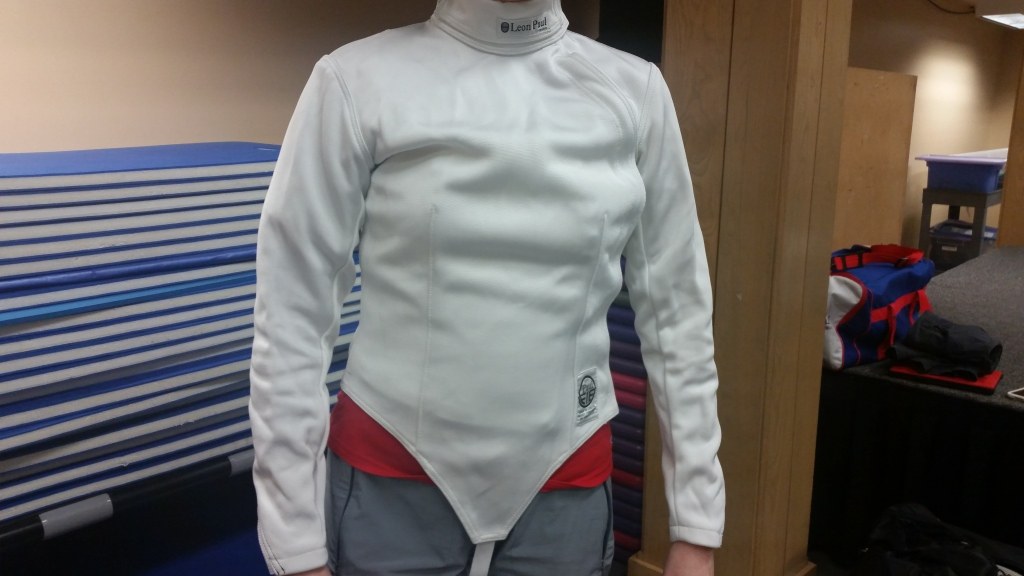 The jacket is long-sleeved and can zip in front or back. Most fencers who buy their own equipment prefer to have the zipper in the front. The zipper on a front zip jacket is on the off-weapon side, so that it is rarely hit by opponents. Most clubs prefer to buy back-zip jackets, as these can be used by both lefties and righties. The jacket comes down to cover the groin in front and has a strap that goes between the legs and connects to the back of the jacket. This helps prevent the jacket riding up.
The jacket is long-sleeved and can zip in front or back. Most fencers who buy their own equipment prefer to have the zipper in the front. The zipper on a front zip jacket is on the off-weapon side, so that it is rarely hit by opponents. Most clubs prefer to buy back-zip jackets, as these can be used by both lefties and righties. The jacket comes down to cover the groin in front and has a strap that goes between the legs and connects to the back of the jacket. This helps prevent the jacket riding up.
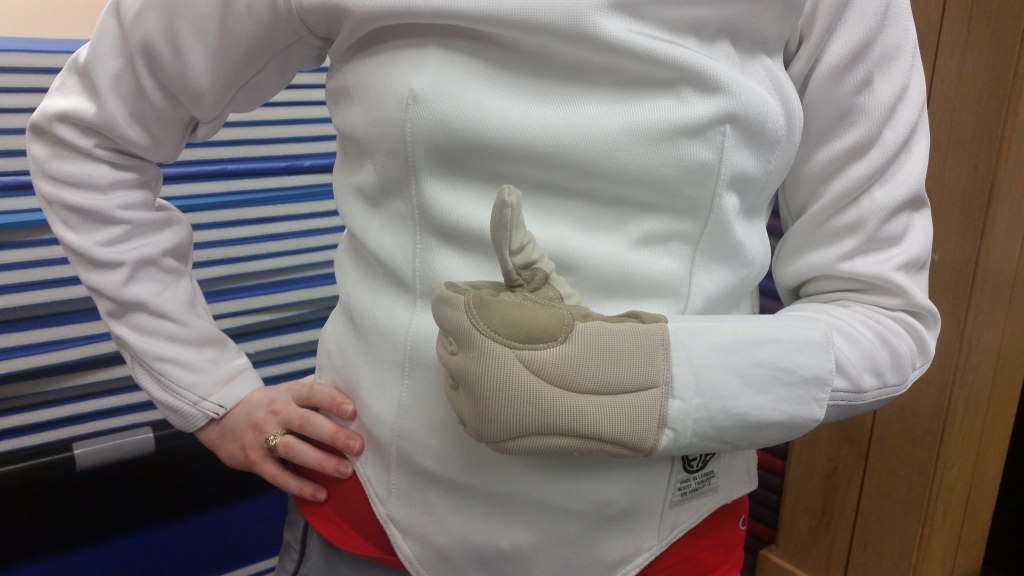 The glove is thick, with a cuff that should cover at least half the forearm. We only wear gloves on our dominant hand, to protect the hand from hits and to help control the weapon. In the age of duels, competitors would issue a challenge by throwing down their glove or gauntlet. We joke that this is the reason that modern fencers only wear one glove – because we would already have thrown the other glove at the opponent before starting the bout.
The glove is thick, with a cuff that should cover at least half the forearm. We only wear gloves on our dominant hand, to protect the hand from hits and to help control the weapon. In the age of duels, competitors would issue a challenge by throwing down their glove or gauntlet. We joke that this is the reason that modern fencers only wear one glove – because we would already have thrown the other glove at the opponent before starting the bout.
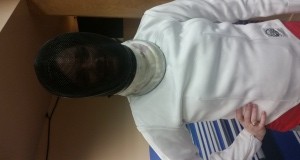 The last piece of safety equipment you put on is also the most important: the mask. It’s made of a strong wire mesh, coated with rubber. The mesh allows you to see and breathe, while still protecting your face from hits. It also includes a thickly padded bib that should cover your neck down to the collarbones, protecting those vulnerable veins, arteries, and your windpipe from direct hits. The mask should fit snugly, with a Velcro strap around the back of your head and a metal tongue to hold it in place. Coach Dan and I have a perfect record of fencers leaving our class with the same number of eyeballs they came in with, and it’s because we insist that fencers always wear their masks when they are holding weapons or standing near people holding weapons.
The last piece of safety equipment you put on is also the most important: the mask. It’s made of a strong wire mesh, coated with rubber. The mesh allows you to see and breathe, while still protecting your face from hits. It also includes a thickly padded bib that should cover your neck down to the collarbones, protecting those vulnerable veins, arteries, and your windpipe from direct hits. The mask should fit snugly, with a Velcro strap around the back of your head and a metal tongue to hold it in place. Coach Dan and I have a perfect record of fencers leaving our class with the same number of eyeballs they came in with, and it’s because we insist that fencers always wear their masks when they are holding weapons or standing near people holding weapons.
All new fencers who enroll in our classes get access to these basic pieces of safety equipment, plus a weapon, from the very first class. Some clubs make new fencers wait a few sessions – sometimes even months – before allowing them to suit up and start hitting and being hit. At Houston Sword Sports, we know that the real reason you came was to get a chance to try swordfighting. We will teach you the fundamentals and still let you have fun by actually participating in the sport.
We know the gear itself isn’t really the selling point of the sport, but safety is a top priority. After all, we can have a lot more fun if we aren’t covered in bruises and gashes and poked-out eyes. Sign up for a class today and we’ll make sure you have a great time and come home in one piece.

